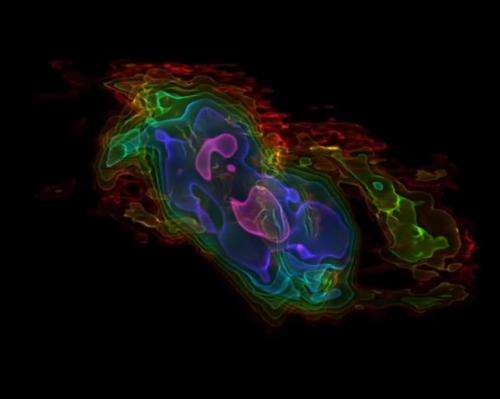New study reveals that stellar winds scatter star-forming material (w/ Video)

(Phys.org) —A University of Alberta astrophysicist's 3-D computer animation is helping an international research team get an unprecedented look at star-forming gases escaping from a nearby galaxy.
Erik Rosolowsky, who recently joined the U of A as an assistant professor of astrophysics, created the animation as part of a new study featured in the journal Nature.
Since 2011, Rosolowsky has been a member of an international collaboration (led by Alberto Bolatto of University of Maryland in College Park) that used the new and powerful Atacama Large Millimeter/submillimeter Array (ALMA) telescope in Chile to discover billowing columns of cold, dense gas fleeing the disk of nearby starburst galaxy NGC 253, also known as the Silver Dollar Galaxy.
Why aren't more stars born?
Located 11.5 million light-years away in the constellation Sculptor, this galaxy affords astronomers a rare and fortuitous view of several super star clusters near its centre. These clusters denote areas where new stars are forming—and also mark the point of departure for material being ejected from the galaxy.
The cosmic fireworks that characterize a starburst can abruptly fizzle out after only a relatively brief period of star formation. As a result, far fewer high-mass galaxies are evident, and astronomers want to know why.
The new study shows in unprecedented detail how vigorous star formation can force hydrogen and other gases high into the surrounding galactic halo, leaving little fuel for the next generation of stars.
Seeing the stellar wind
Rosolowsky worked on mass calculations for the study before creating the 3-D animation that helped the team identify the stellar wind movement. "We couldn't see the wind before the new telescope," he said.
The ALMA telescope provided enough data for Rosolowsky to build a computer visualization that revealed a phenomenon that was difficult to discern by physical observation. To create the 3-D animation, he included data about the distance, brightness and velocity of carbon monoxide molecules in the starburst.
The different colours represent the brightness of the gas at various points. The top of the structure is moving toward Earth; the bottom part is farther away. The solar wind appears as a yellow, peanut-shaped formation near the top of the structure.
"Part of the complexity is seeing something very faint next to something very bright," Rosolowsky said. "This is the first time we've used this type of visualization for these data. Usually, we use these methods to visualize computer simulations."
Rosolowsky says he is looking forward to using the ALMA data for more research. He notes that ALMA has similar data for other molecules, and further study should help determine how much gaseous material is carried away by stellar winds. He will be studying the structure of all the molecular gas, seeking to understand how these clouds create the starbursts seen in this and other galaxies.
More information: www.nature.com/nature/journal/ … 59/full/499416a.html
Journal information: Nature
Provided by University of Alberta



















